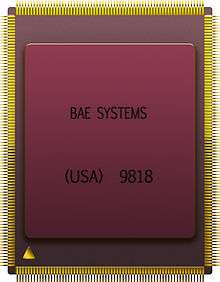IBM RAD6000
 The RAD6000 processor | |
| Produced | From 1997 to present |
|---|---|
| Marketed by | BAE Systems |
| Designed by | IBM |
| Common manufacturer(s) | |
| Max. CPU clock rate | 2.5 MHz to 33 MHz |
| Min. feature size | 0.5 μm |
| Instruction set | POWER1 |
| Cores | 1 |
| L1 cache | 8 KB |
| Successor | RAD750 |
| Application | Radiation hardened for use in spacecraft |
| Power Architecture |
|---|
| Made by Freescale |
| Made by IBM |
| IBM-Nintendo collaboration |
| Other |
| Related links |
| Cancelled in gray, historic in italic |
The RAD6000 radiation-hardened single board computer, based on the IBM RISC Single Chip CPU, was manufactured by IBM Federal Systems. IBM Federal Systems was sold to Loral, and by way of acquisition, ended up with Lockheed Martin and is currently a part of BAE Systems United States subsidiary BAE Systems Inc. operating group BAE Systems Electronics, Intelligence & Support. RAD6000 is mainly known as the onboard computer of numerous NASA spacecraft.
The radiation-hardening of the original RSC 1.1 million-transistor processor to make the RAD6000's CPU was done by IBM Federal Systems Division working with the Air Force Research Laboratory.
As of June 2008, there are 200 RAD6000 processors in space on a variety of NASA, United States Department of Defense and commercial spacecraft, including:
- the Spirit and Opportunity Mars rovers
- the Mars Pathfinder lander
- the Deep Space 1 probe
- the Mars Polar Lander and Mars Climate Orbiter
- the Mars Odyssey orbiter
- the Spitzer Infrared Telescope Facility
- the MESSENGER probe to Mercury
- the STEREO Spacecraft
- the IMAGE/Explorer 78 MIDEX spacecraft
- the Genesis and Stardust sample return missions
- the Phoenix Mars Polar Lander
- the DAWN Mission to the asteroid belt using ion propulsion
- the Solar Dynamics Observatory, Launched Feb 11, 2010 (flying both RAD6000 and RAD750)[1]
- the Burst Alert Telescope Image Processor on board the Swift Gamma-Ray Burst Mission
- the DSCOVR Deep Space Climate Observatory spacecraft
The computer has a maximum clock rate of 33 MHz and a processing speed of about 35 MIPS.[2] In addition to the CPU itself, the RAD6000 has 128 MB of ECC RAM.[2] A typical real-time operating system running on NASA's RAD6000 installations is VxWorks. The Flight boards in the above systems have switchable clock rates of 2.5, 5, 10, or 20 MHz.
Reported to have a unit cost somewhere between US$200,000 and US$300,000, RAD6000 computers were released for sale in the general commercial market in 1996.
The RAD6000's successor is the RAD750 processor, based on IBM's PowerPC 750.
See also
- PowerPC 601, a consumer chip with similar computing capabilities to the RAD6000
- POWER1, the architecture family the RAD6000 belongs to
- IBM RS/6000
References
- ↑ Press Release http://www.reuters.com/finance/stocks/keyDevelopments?rpc=66&symbol=BAESY.PK×tamp=20100217165200
- 1 2 "RAD6000 Space Computers" (PDF). BAE Systems. 2008-06-23. Retrieved 2009-09-07.
External links
- Software on Mars rovers 'space qualified' – By Matthew Fordahl/AP, 23 January 2004
- AFRL Rad6000 fact sheet
- Software Behind the Mars Phoenix Lander (Audio Interview)
- The CPUs of Spacecraft Computers in Space